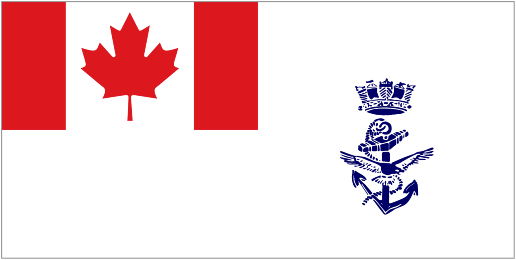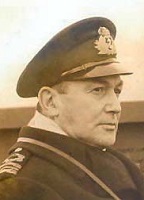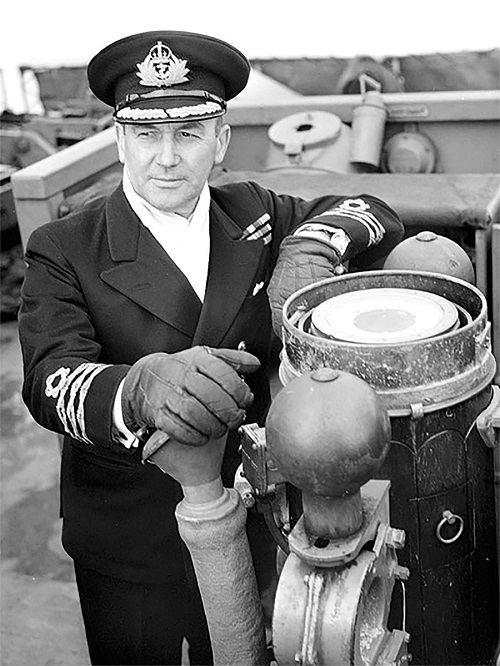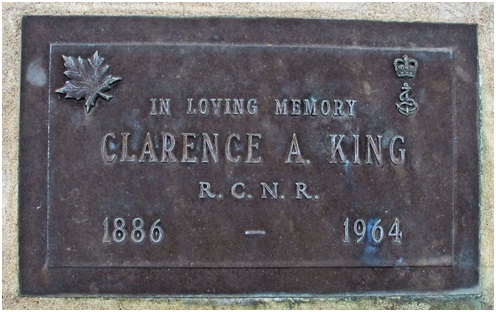|
A Royal Canadian Navy Historical Project
In memory of those who have Crossed the Bar
U-Boat Destroyer Captain King Dies - Crowsnest Magazine Feb 1964, Pg. 22
Decorated in two world wars for destroying U-boats, Captain Clarence A. King, DSO, DSC and Bar, RCNR (Ret), died at home at Osoyoos Lake, B.C., on February 9 at the age of 77. Born in Islington, London Borough of Islington, Greater London, England, Captain King served in the British merchant service for a time, then settled in Canada before the First World War. In 1916 he joined the Royal Naval Reserve. He served in "Q-ships" and commanded one of these U-boat killers for the last 15 months of hostilities. During this time he was credited with one sure kill and two probable's. He was awarded the Distinguished Service Cross. When he returned to Canada, Captain King settled in the British Columbia interior. He was operating a fruit farm near Oliver when the Second World War began. He immediately volunteered and was attached to the Royal Naval Control Service on the America West Indies Station, serving in Panama and Bermuda. Early in 1942 he transferred to the Royal Canadian Naval Reserve with the rank of Lieutenant-Commander. He commanded the Bangor minesweeper HMCS Nipigon briefly and then took command of the corvette Oakville, in which he scored a spectacular success against a U-boat in the Caribbean. The German submarine, flushed by a U.S. aircraft, was attacked by the Oakville with gunfire and depth charges and then rammed three times. The corvette was brough alongside the damaged U-boat and a two-man boarding party forced the surrender of the Germans. This exploit brought Captain King the Distinguished Service Order and the United States Legion of Merit, the first U.S. decoration to be awarded to a Canadian during the Second World War. In 1943, Captain King was given command of the frigate Swansea. On her first convoy trip in March 1944, she helped the River class destroyer St. Laurent kill a U-boat in the North Atlantic. A month later the Swansea teamed with HMS Pelican to destroy U-448. It was only a month after Captain King had relinquished command that the Swansea helped to sink a third U-boat. He subsequently commanded the frigates Prince Rupert and Runnymede. He was promoted to Captain on Jan 1, 1946, while serving as Staff Officer (Operations) to the Commanding Officer Pacific Coast at Esquimalt. In peacetime, Captain King was active in Kokannee community affairs. He was prominent in church work and was chairman of the board of management of St. Martin's Hospital at Oliver. He leaves his wife, two sons, two daughters, seven grandchildren and four great-grandchildren. A son Ronald, was killed in Sicily while serving with the Seaforth Highlanders. He is buried in Osoyoos Lakeview Cemetery, Osoyoos, Okanagan-Similkameen Regional District, B.C.
U-boat chaser Clarence King: Fire-eater and humanitarian - Lookout Magazine, May 01, 2020
“It made my hair stand on end a bit to be stopped in U-boat waters!” a crew member of His Majesty’s Canadian Ship (HMCS) Swansea said about the decision of his commanding officer – Commander Clarence King – to rescue survivors from a sinking German U-boat. It was March 10, 1944, when U-boat 845 first made contact with an Allied convoy in the North Atlantic. The Battle of the Atlantic, the struggle between the Allied and German forces for control of the Atlantic Ocean, was at its height. The Allies needed to keep the vital flow of men and supplies going between North America and Europe, where they could be used in the fighting, while the Germans wanted to cut these supply lines. To do this, German U-boats and other warships prowled the Atlantic Ocean sinking Allied transport ships. But in this case, as U-845 made contact with the convoy, it was picked up by an escort, HMCS St. Laurent, and depth-charged. When the U-boat surfaced later that night, it was attacked by St. Laurent and three other escorts of 9th Escort Group: HMCS Swansea, HMCS Owen Sound and His Majesty’s Ship (HMS) Forester. There was some danger of the ships firing into or colliding with each other in the excitement, and it took skill to prevent that from happening. The combined firepower was too much for the U-boat, and its crew began abandoning the sinking submarine. King had his boarding party standing by but felt it unwise to risk the lives of his men as the submarine was sinking by the stern. He lay stopped in the water while survivors were rescued, despite the agitation of his crew members who were wary of other possible U-boats in the area. For King, rescuing survivors took precedence over any possible danger. At the time, he was 58 years old, on the old side for modern naval warfare. Born on the outskirts of London, England, in 1886, he went to sea as a cadet at the age of 13. By 25 he had gained his foreign-going steamship Master’s certification. After marrying, he moved to Kamloops, B.C., just as the First World War got under way. He settled his family in Winnipeg and returned to England where he joined the Royal Naval Volunteer Reserve as a sub-lieutenant. In January 1917, King was appointed for duty in a Motor Launch on submarine patrols in the English Channel, before being transferred to Special Service Ship Merops. This small vessel, disguised as a merchant ship and fitted with considerable hidden armament, was designed to attract and attack U-boats. It was with this ship that King earned his first Distinguished Service Cross for a spirited action with a U-boat. Both the U-boat and Merops were seriously damaged. After being demobilized in 1918 with the war’s end, he returned to Winnipeg and later moved his family back to the Okanagan Valley in British Columbia. It was the Second World War that brought him back from a life of farming to the sea. With the outbreak of the war, he immediately rejoined the naval service and was sent to Panama and Bermuda as a Naval Control of Shipping Officer. In 1942, he transferred to the Royal Canadian Naval Reserve and was given command of the Bangor-class minesweeper HMCS Nipigon. Soon after he assumed command of the corvette HMCS Oakville. It was while in command of this warship that he engaged U-boat 94 in the Caribbean Sea. On August 28, 1942, in the company of American warships and the corvettes Halifax and Snowberry, Oakville was escorting a convoy off Haiti when it was attacked by U-94. The submarine, which had been on the point of attacking the convoy, was first spotted and bombarded by an American seaplane. Oakville dropped depth charges to force it to surface, and after bombarding it, rammed the submarine twice. Struck by another depth charge on the surface, U-94 gave up the fight. King brought his ship alongside the badly damaged submarine and several of his crew boarded the boat to search for codebooks and other documents. As the U-boat began sinking rapidly, Oakville crew members and surviving Germans abandoned it and were picked up from the sea. It was a valuable kill as U-94 had sunk 28 ships since December 1940. For this action King was awarded a Distinguished Service Order and the American Legion of Merit. “When in the face of the enemy he was a real fire-eater,” said one of his crew after the battle. “But when that enemy was vanquished, he became a humanitarian and did more than was the minimum required to rescue any survivors.” Several months later, King was appointed to command Swansea, commissioning the corvette on the West Coast and then sailing it to Halifax in October 1943 to begin its war service. After his courageous action with U-boat 845, King continued to escort convoys, eventually finishing the war as senior officer of C-5 Escort Group. A glimpse of the nature that endeared him to his crews over the course of his career was noted the morning after an enemy action when he approached a sailor in the ship. “Were you scared last night?” he asked. When the sailor replied, “Yes sir, I was scared stiff!” King responded, “Me too!” As a man old enough to be the father of most corvette captains, King was often referred to as “Uncle Clarence”. A well-respected and compassionate leader, his crews described him as a courteous gentleman, considerate and calm, and sympathetic to their needs. In battle, however, he was brave and forceful, a consummate seaman and excellent navigator. After the war, King bought a fruit farm in the Okanagan Valley and settled back into the life of a farmer. He died in 1964.
Ships served in: HMCS SASKATOON - 3rd Commanding Officer - 05 Feb 1942 - 14 Feb 1942 as an A/LCdr, RCNR (Macpherson-Burgess - Ships of Canada's Naval Forces 1910-1981) HMCS NIPIGON - 2nd Commanding Officer - 15 Feb 1942 - 11 May 1942 as an A/LCdr, RCNR (Macpherson-Burgess - Ships of Canada's Naval Forces 1910-1981) Appointed to NIPIGON 15 Feb 1942 as an A/LCdr, RCNR, CO (Navy List Apr 1942) HMCS OAKVILLE - 2nd Commanding Officer - 12 May 1942 - 21 Apr 1943 as a LCdr, RCNR (Macpherson-Burgess - Ships of Canada's Naval Forces 1910-1981) HMCS SWANSEA - 1st Commanding Officer - 04 Oct 1943 - 29 Jul 1944 as an A/Cdr, RCNR (seniority 01 Jan 1943) (Macpherson-Burgess - Ships of Canada's Naval Forces 1910-1981) (Navy List Jul 1944) HMCS PRINCE RUPERT - Appointed to PRINCE RUPERT 01 Aug 1944 as an A/Cdr, RCNR (Navy List Sep 1944 / Nov 1944) Note: Macpherson-Burgess, Ships of Canada's Naval Forces 1910-1981 lists him as CO from 01 Aug 1944 - 23 Oct 1944, however, the Navy List up to Nov 1944 lists LCdr Robert Draney as CO during that time frame. For the purpose of this website, unless other official documentation can be found to the contrary, the Navy List shall be considered as the correct information. HMCS KOKANEE - Appointed to KOKANEE 24 Oct 1944 as an Cdr, RCNR (seniority 01 Jan 1945) (Navy List Jan 1945) HMCS SEA CLIFF - Appointed to SEA CLIFF as a Cdr, RCN(R) (Navy List May 1945) HMCS RUNNYMEDE - 5th Commanding Officer - 09 Jun 1945 - 09 Aug 1945 as a Cdr, RCNR (Macpherson-Burgess - Ships of Canada's Naval Forces 1910-1981) HMCS GIVENCHY - Appointed to GIVENCHY 10 Aug 1945 as Staff Officer (Operations) to Commanding Officer Pacific Coast as a Capt, RCNR (seniority 01 Jan 1946) (Navy List Apr 1946) * Retired List as a Capt, RCN(R) (seniority 01 Jan 1946) (Navy List Jul 1946) HMCS DISCOVERY (Retired List) - as a Capt, RCN(R) (seniority 01 Jan 1946) (Navy List Jul 1952). Last noted in the Navy List of Jan 1960 on the retired list at HMCS Discovery as a Capt, RCN(R) (seniority 5 years 243 days) (Navy List Jan 1960)
A/Cdr King on HMCS SWANSEA
Commander Clarence King DND/RCN photo Source: Lookout Magazine, May 2020
Headstone for Capt. Clarence A. King Source: Find-a-Grave
|
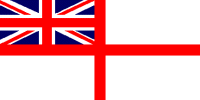 For Posterity's Sake
For Posterity's Sake 